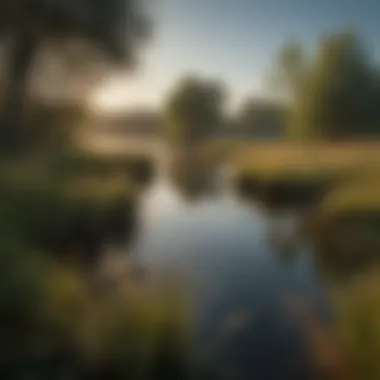Effective Strategies for Controlling Invasive Lake Reeds


Intro
Lake reeds present significant challenges in many aquatic ecosystems. Their invasive nature can disturb the balance of local flora and fauna. Understanding effective management strategies is essential for preserving the ecological integrity of these environments. This article aims to provide forestry professionals and landowners with a comprehensive guide on best practices and implementations for managing lake reeds.
This discussion will clarify the importance of forestry practices and their roles in ecosystem management. We will explore sustainable management techniques that can be employed to combat the growth of invasive reed species while maintaining water quality and promoting biodiversity in aquatic habitats.
Understanding Lake Reeds
Lake reeds are a significant component of many aquatic ecosystems. Their ecological role varies, affecting both the environment and human interactions with these bodies of water. Understanding the intricacies of lake reeds is essential for effective management and maintaining waterway health. This section delves into the characteristics of reeds, their impact on the ecosystem, and how to identify potentially invasive species.
Characteristics and Growth Patterns
Lake reeds typically exhibit robust growth patterns, flourishing in wetland environments. They have tall, slender stems that can reach heights of over two meters. Reeds often grow in dense clusters, forming extensive mats in shallow water. This growth habit provides stability in the ecosystem but can also lead to overgrowth, impacting other plant species. The rhizomatous nature of reeds promotes rapid spread, making their management a complex issue.
Ecological Role and Impact
The role of lake reeds in aquatic ecosystems is multifaceted. They contribute positively in some instances while also presenting challenges. Their contribution can be seen in specific aspects below:
Benefits of Reeds in Aquatic Environments
Reeds provide numerous ecological benefits. They serve as natural filters, improving water quality by trapping sediments and absorbing nutrients. This filtration process enhances the clarity of the water, which can be critical for the survival of various aquatic species. Additionally, the dense structure of reed beds creates habitat areas for fish and invertebrates, promoting biodiversity.
Another important feature of reeds is their ability to stabilize shorelines. Their root systems hold soil in place, reducing erosion during heavy rains or floods. This stabilization is crucial for maintaining the integrity of nearby land. Overall, the presence of reeds is often seen as beneficial in controlled environments, supporting healthy aquatic ecosystems.
Negative Effects on Biodiversity
Conversely, lake reeds can also impose negative effects on biodiversity. The rapid proliferation of invasive variants can dominate space, limiting sunlight and resources available to native species. When this occurs, it creates a less hospitable environment for other aquatic plants and animals, leading to a decline in biodiversity.
Furthermore, thick mats of reeds can obstruct movement for aquatic organisms, disrupting food chains and reproductive cycles. This can result in less biodiversity over time, undermining the ecological balance within the waterway. Understanding these impacts is crucial for developing comprehensive management strategies.
Identifying Invasive Species Variants
Identifying invasive species variants of lake reeds is essential for effective management. Some common invasive variants, such as Phragmites australis, can spread rapidly and often outcompete native flora. Their identification typically involves observing characteristics such as stem height, leaf width, and flowering types. Proper identification allows for targeted removal and management strategies to restore native ecosystems, ultimately promoting a healthier aquatic environment.
Reasons for Removal
Understanding the reasons for the removal of lake reeds is essential for effective management and preservation of aquatic ecosystems. Lake reeds can significantly impact water quality, local flora and fauna, and even the aesthetics and recreational aspects of these environments. Each of these factors warrants careful consideration in planning removal strategies.
Impact on Water Quality
The presence of dense lake reeds can lead to various water quality issues. First, they contribute to stagnation, as their growth can block water flow and reduce oxygen levels in the water. This stagnation can cause an increase in harmful algae blooms, which consume available oxygen and can produce toxins harmful to aquatic life and human health. Additionally, reeds can trap organic debris and detritus, creating a breeding ground for bacteria. If left unaddressed, the decline in water quality will not only damage aquatic life but will likely also affect nearby communities that rely on the water for drinking or recreational activities.
- Reduced Oxygen Levels: Stagnant water leads to lower oxygen levels, affecting fish and other aquatic organisms.
- Algal Blooms: Poor water flow promotes harmful algal blooms which can be toxic.
- Bacterial Growth: Accumulation of organic matter increases bacterial populations, posing health risks.
Influence on Local Flora and Fauna
Lake reeds also have adverse effects on local biodiversity. They can outcompete native plant species for resources such as light, nutrients, and space. This displacement can lead to decreased plant diversity and negatively impact the animals that rely on these native plants for food and habitat. The loss of native vegetation can disrupt food webs, leading to cascading effects throughout the ecosystem.
- Competition for Resources: Reeds can dominate habitats, pushing out native plants.
- Habitat Loss: Native animals may find it challenging to thrive in ecosystems where their food sources are diminished.
- Disrupted Food Systems: The changes in plant life can significantly affect the animal populations that depend on those plants.
Aesthetic and Recreational Concerns
From a human perspective, lake reeds can affect the visual appeal of a body of water, detracting from its recreational value and enjoyment. Thick mats of reeds can block views and make navigation difficult for boaters and anglers, who prefer cleaner waters for fishing or engaging in water sports. Maintaining visual aesthetics can enhance community pride and potentially increase property values in areas bordering these lakes. Effective management strategies can help restore the balance and keep these areas enjoyable for all.
"Management of reed populations not only benefits the ecosystem but also enhances the spaces used for recreation and community enjoyment."
In summary, the reasons for removing lake reeds extend far beyond mere aesthetics. Addressing their impact on water quality, local flora and fauna, and recreational spaces contributes to the overall health of aquatic systems and the communities that rely on them.
Assessment Before Action
Understanding the immediate need to assess conditions before undertaking any management of lake reeds is crucial. This assessment provides insights into the extent of infestations and informs future actions. It helps to ensure that any intervention is both effective and ecologically appropriate. A thorough assessment can save time, resources, and potentially avoid negative consequences on the ecosystem.
Evaluating Infestation Levels


Evaluating the levels of lake reed infestation is the first step in the management process. It involves mapping the distribution and density of reeds in the affected area. This data allows for a better understanding of the scale of the problem. Using tools like satellite imagery and field surveys can provide accurate insights.
The key characteristics to focus on during this evaluation include:
- Density: How thickly the reeds are growing in particular areas.
- Distribution: Identifying hot spots where reed growth is more concentrated.
- Diversity: Examining the presence of other plant species in the area, as an abundance of reed could suppress biodiversity.
These metrics are essential for developing a targeted approach to removal efforts.
Environmental Impact Considerations
When assessing the impact of removing lake reeds, several environmental consequences must be taken into account. The removal process can have significant ramifications on both the immediate ecosystem and the surrounding environment.
Assessment of Surrounding Ecosystems
Evaluating surrounding ecosystems is essential to understand the broader effects of reed management. Lake reeds often provide habitats and food sources for various organisms. Removing them indiscriminately could disrupt these ecological relationships.
Key factors to consider in this assessment include:
- Biodiversity Loss: The removal of reeds can lead to the loss of species that depend on them.
- Nutrient Cycling: Reeds play a role in nutrient cycling; their absence might alter nutrient dynamics in water systems.
Therefore, understanding these interactions is beneficial for ensuring that management does not exacerbate existing ecological issues.
Long-term Implications of Removal
The long-term implications of removing lakes reeds encompass several factors that can affect future management efforts. It is vital to recognize that immediate results may not reflect future conditions.
Key aspects include:
- Regrowth Potential: Some reed varieties can proliferate rapidly after removal, necessitating continued management.
- Erosion Risks: Removing vegetation can destabilize soil health and contribute to erosion in the area.
These considerations underscore the importance of developing a comprehensive long-term management plan that addresses both the immediate and future state of the ecosystem.
Mechanical Removal Techniques
Mechanical removal techniques play a crucial role in managing lake reeds. These methods aim to eliminate or reduce reed populations in a systematic manner, facilitating better control of this invasive species. Unlike chemical approaches, mechanical methods primarily rely on physical intervention, thus minimizing the introduction of additional chemicals into the ecosystem. This approach not only promotes a healthier aquatic environment but also allows for immediate visible results, which is often essential for landowners and environmental groups seeking effective solutions.
Manual Removal Strategies
Manual removal strategies are essential for scenarios where reed infestations are manageable and localized. They provide a hands-on approach that can be effective in small-scale situations, minimizing disruption to the surrounding habitat.
Best Tools for Manual Extraction
Selecting the right tools for manual extraction is key to the success of reed removal efforts. Common options include hand tools such as spades, hoes, and saws. These tools are favored for their versatility and the control they provide the user. For instance, a sharp spade allows for precise cutting of the reed roots, effectively preventing regrowth.
Advantages of Using Hand Tools:
- Low Impact: Manual tools have minimal impact on the surrounding environment.
- Cost-Effective: They are generally less expensive compared to machinery.
Disadvantages of Using Hand Tools:
- Labor-Intensive: The process can be physically demanding and time-consuming.
- Limited Range: Accessibility can be an issue in wetter areas.
Timing for Effective Removal
Timing is critical when it comes to the removal of lake reeds. The optimal period for manual extraction is typically in late spring just before the plants reach full growth. This timing ensures that the roots are easier to uproot and that the plants have not yet produced new seeds.
Advantages of Timely Removal:
- Increased Success Rate: Removing reeds during their early growth stages significantly lowers their chances of returning.
- Better Resource Allocation: Efficient timing allows for focused efforts during the growing season, leaving additional resources for other areas of management.
Disadvantages of Late Removal:
- Increased Difficulty: Removing densely packed reeds later in the season can be more challenging.
- Higher Seed Production: Delaying removal may result in higher seed dispersal, complicating future management efforts.


Use of Machinery
While manual removal can be effective, the use of machinery becomes necessary in larger infestations or when quick action is required. Employing machines can significantly expedite the removal process and cover larger areas more efficiently.
Types of Machinery for Aquatic Land
Several types of machinery can be employed for the removal of lake reeds. Aquatic weed harvesters are commonly used. These machines are specifically designed for navigating water bodies, allowing for effective harvesting without causing harm to the aquatic environment. Another option includes swamp buggies that can maneuver through marshy areas without getting stuck.
Benefits of Aquatic Machinery:
- Speed: They allow for rapid removal of large volumes of reeds.
- Efficiency: Machines can access areas inaccessible to human labor.
Drawbacks of Aquatic Machinery:
- Cost: The initial investment and maintenance expenses can be significant.
- Environmental Impact: Poorly operated machines can disturb sediments and harm aquatic life.
Safety and Environmental Precautions
When using machinery for the removal of lake reeds, safety and environmental precautions must be prioritized. Operators should be trained to handle equipment properly to ensure safety on the water. Furthermore, it is crucial to assess environmental factors, such as water currents and aquatic life, prior to operation.
Key Safety Measures Include:
- Proper Training: Ensuring those operating the equipment are properly trained to avoid accidents.
- Regular Equipment Checks: Conduct regular maintenance on machines to prevent spills and malfunctions.
Environmental Considerations:
- Minimize Disturbance: Operators should aim to minimize disturbance to surrounding habitats.
- Avoid Heavy Machinery on Sensitive Areas: Heavy equipment should not be used in fragile ecosystems to prevent damage.
Chemical Control Methods
In addressing the challenge of managing lake reeds, chemical control methods play a pivotal role. These techniques involve the application of herbicides, which are formulated to selectively target invasive reed species while minimizing harm to desirable flora and fauna. Understanding their utility, benefits, and potential risks is crucial for effective management practices. Utilizing chemical control can lead to significant reductions in reed biomass, ultimately restoring the ecological balance within aquatic environments. However, it is imperative to adhere to guidelines, as improper use can result in adverse ecological outcomes.
Types of Herbicides Available
Herbicides have varied formulations and modes of action. Some of the most common herbicides used for lake reed management include:
- Glyphosate: A non-selective herbicide effective in controlling a broad spectrum of plant types, including lake reeds. It works by inhibiting a specific enzyme pathway essential for plant growth.
- Imazapyr: A selective herbicide that disrupts amino acid synthesis, often used in wetland areas where other plants may need protection.
- Aquatic formulations of 2,4-D: Specifically designed for use in water, these formulations target broadleaf plants while being less harmful to grasses and other aquatic life.
When choosing a herbicide, consideration of the specific context and the target reed species is key.
Application Techniques and Timing
Successful chemical control is not only reliant on the herbicide choice but also on proper application techniques and timing. Effective methods include:
- Spot Treatment: Applying herbicide directly onto the target reeds using a backpack sprayer or a wick applicator. This reduces the risk of damaging non-target species.
- Broadcast Spraying: Best suited for larger infestations, this method requires careful planning to minimize drift and off-target effects.
- Timing: Application should occur when reeds are actively growing, typically in late spring or early summer. Additionally, treating during dry weather ensures effective uptake, maximizing the herbicide's impact.
Evaluating Ecological Risks
When employing chemical control methods, a rigorous evaluation of ecological risks is vital. Factors that must be considered include:
- Non-target effects: Understanding how the chosen herbicide may affect surrounding plants and animals is a key consideration. Herbicides can persist in the environment, impacting local biodiversity.
- Water quality: Herbicide runoff can pose a risk to water quality, affecting fish and other aquatic organisms.
- Synergistic effects: The interaction between different chemicals can lead to enhanced toxicity, creating unforeseen consequences for local ecosystems.
It is essential for the management plans to encompass a holistic view of ecological interactions, ensuring sustainable lake reed control without compromising the integrity of aquatic ecosystems.
Effective chemical control methods require careful planning and invasive species knowledge to achieve desired outcomes without endangering aquatic biodiversity.
Integrated Management Practices
In the fight against lake reefs, integrated management practices are essential. These strategies combine various methods to create a holistic solution. It considers the strengths and weaknesses of both mechanical and chemical removal methods. This integrated approach maximizes effectiveness while minimizing potential harm to the ecosystem. It also helps in creating a sustainable management plan. The goal is not just to remove the reeds but to prevent their return in the future.
Combining Mechanical and Chemical Methods
Mechanical removal and chemical treatment are two common strategies used to manage lake reeds. Using these in tandem can lead to more successful outcomes. Mechanical removal can involve methods such as cutting, mowing, or even dredging. These are effective methods for reducing biomass and making a notable impact on the reed population.


On the other hand, chemical methods utilize herbicides. Applying chemicals after mechanical removal can help eliminate the remaining roots and shoots that may still survive. Effective timing of this combination is crucial. Applying herbicide too soon after mechanical removal may lead to ineffective treatment, while waiting too long can allow reeds to regrow. Thus, understanding both methods and their timing is essential for a successful integrated approach.
"The combination of mechanical and chemical methods provides a layered defense against the rapid regrowth of lake reeds."
Implementing both methods requires careful planning. Factors such as the current ecosystem, local regulations, and potential impacts on non-target species need consideration. Always strive to use herbicides sparingly and in compliance with environmental regulations.
Monitoring and Follow-up Procedures
Monitoring and follow-up procedures are critical components of integrated management practices. Once initial management actions are taken, ongoing assessment needs to ensure the effectiveness of the strategies implemented. This phase is important to detect any potential regrowth of lake reeds early and address it before it becomes a larger problem.
There are several aspects involved in the monitoring process:
- Regular Surveys: Periodic inspections of treated areas are vital. This helps in noticing any signs of regrowth or new infestations.
- Data Documentation: Keeping detailed records of the methods used, areas treated, and outcomes observed aids in future planning. This can be beneficial in refining strategies over time.
- Engagement with Experts: Collaborating with ecological experts can provide additional insights into the effectiveness of practices applied and suggest adaptive management if required.
It is crucial to understand that managing lake reeds is an ongoing process. Merely addressing the problem once is often insufficient. Continuous observation and proactivity are essential to maintain healthy aquatic ecosystems. Only by diligently monitoring and adjusting management strategies can one hope to achieve long-term success in controlling lake reeds.
Long-term Management and Prevention
Long-term management and prevention strategies are vital for the effective control of lake reeds. While immediate removal might offer temporary relief, it is crucial to engage in practices that minimize the likelihood of regrowth. Sustainable solutions help maintain the health of aquatic ecosystems, ensuring that they remain balanced and productive for future generations. This section will explore such practices while emphasizing the need for a comprehensive approach.
Sustainable Practices to Prevent Regrowth
Native Plant Restoration
Native plant restoration plays a significant role in long-term management of lake reeds. Introducing native species helps create a balanced ecosystem. These plants can outcompete invasive reeds for resources, effectively reducing their spread. The key characteristic of native plants is their adaptability to local conditions, which makes them resilient and therefore a beneficial choice for freshwater environments.
The unique feature of native plant restoration is its focus on biodiversity. Encouraging the growth of various native species can enhance habitat for wildlife, crucial for maintaining ecological balance. However, it does require ongoing monitoring to ensure the introduced plants thrive and to manage any potential setbacks effectively.
Water Quality Management
Water quality management is also a critical aspect of preventing the regrowth of lake reeds. Maintaining high water quality can inhibit conditions favorable for reed growth. This involves monitoring factors such as nutrient levels, sedimentation, and pH balance, which are essential for a healthy ecosystem. A key characteristic of this approach is its emphasis on proactive measures, making it a popular choice among environmentalists.
The unique aspect of water quality management is that it addresses the root causes of reed proliferation. By ensuring that the water is clean and balanced, the environment becomes less hospitable for invasive species, including reeds. However, this practice demands consistent effort and collaboration among stakeholders to achieve measurable results.
Community Involvement and Education
Engaging Local Stakeholders
Engaging local stakeholders is an essential component of effective lake reed management. Involving community members fosters a sense of ownership over local ecosystems. This can lead to better enforcement of sustainable practices. A key characteristic of engaging stakeholders is that it empowers individuals to participate in decision-making processes. This participatory approach proves beneficial, as community members often possess valuable local knowledge.
One unique feature of this engagement is that it can mobilize volunteers for monitoring and restoration activities. The advantages include increased community awareness and commitment to ecological stewardship. However, challenges can arise in aligning diverse interests. Finding common ground is crucial for long-term success.
Educational Programs and Initiatives
Educational programs and initiatives are critical in promoting awareness about lake reed challenges. Such programs can inform stakeholders about effective management strategies and encourage environmentally responsible behaviors. The key characteristic of these initiatives is their ability to disseminate knowledge widely, making information accessible to a broad audience.
A unique feature of educational programs is their adaptability; they can be tailored to different demographics within the community, ensuring that all voices are heard. The advantages of this approach are clear—increased knowledge leads to better practices. However, the downside might be that without proper funding or resources, sustained outreach can be difficult.
To effectively manage lake reeds, a combination of methods must be employed, focusing on prevention, community involvement, and education.
The End and Recommendations
Managing invasive lake reeds requires a combination of effective strategies and long-term planning. In this article, it has been emphasized that understanding the ecological implications of lake reeds and their impact is essential. Goals should include not only removing the reeds but also ensuring that aquatic ecosystems can thrive afterward. Recommendations incorporate techniques that are sustainable and promote the restoration of native plants.
A key benefit of these management practices is the improvement of water quality. Implementing methods that focus on manual and chemical removal ensures that the reeds do not further damage the ecosystem. Taking action prepares the way for more biodiversity, enhancing both flora and fauna. Collaboration among various stakeholders adds strength to the overall efforts.
Summary of Effective Strategies
- Assessment and Planning: Careful evaluation of lake reed infestation should guide the specific methods chosen for removal. Knowing the extent of growth helps determine whether manual or mechanical interventions are more effective.
- Combining Techniques: Using both mechanical removal and herbicides can be helpful. Each has its strengths. Manual removal is best for small areas, while machinery is suitable for larger infestations.
- Community Involvement: Engaging local communities can enhance the effectiveness of management efforts. Educational programs can help in raising awareness and support.
- Monitoring and Follow-up: Continuous monitoring after the initial removal is important. Regular follow-up can prevent new growth and allow treatment adjustments as needed.
Final Thoughts on Ecosystem Management
Ecosystem management is a complex task, yet it holds significant promise for restoring and maintaining healthy aquatic environments. Lake reeds create challenges that require nuanced approaches.
- Long-Term Perspective: It is critical to focus on long-term management instead of short-term fixes. Policies and practices should consider the broader ecological context.
- Adaptation and Research: Ecosystems are dynamic, and strategies to manage invasive species should adapt accordingly. Ongoing research into effective methods and outcomes can inform future efforts.
The combined effort of forestry professionals, local communities, and environmental organizations will enhance effectiveness and leads to sustained success in managing lake reeds for a healthier ecosystem.
"Sustainability in lake reed management not only means addressing current issues but also anticipating future challenges."
Practicing these strategies will ensure that waterways remain healthy and vibrant for future generations.







